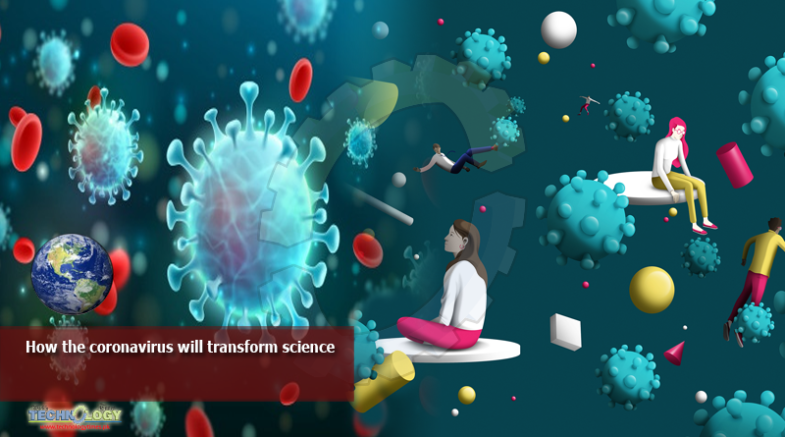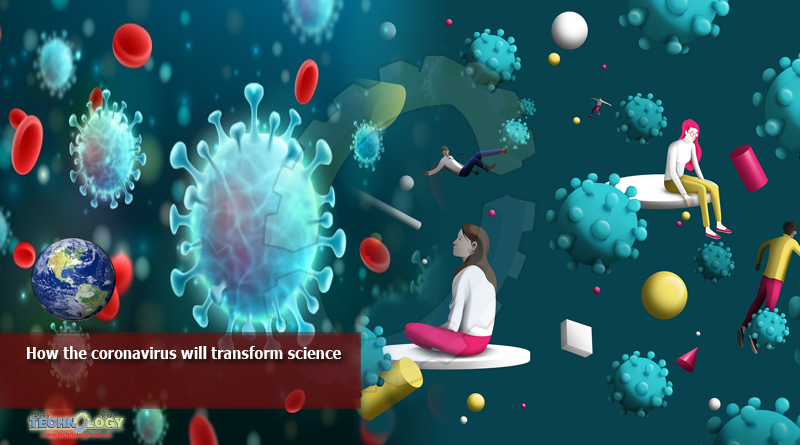Companies are getting new diagnostics, vaccines, and treatments into the clinic at lightning speed coronavirus. Scientists are publishing results on preprint servers practically in real time and using social media to communicate their findings on COVID-19, the disease caused by the virus. Those not directly involved in the coronavirus efforts scoured their labs for gloves, masks, and reagents to donate.

Will they help?Searching for a coronavirus cure in the bloodAcademic, government, and industry labs mobilized to quickly understand key viral proteins. Researchers worked collaboratively in unprecedented numbers across institutions and corporations to explore the potential for existing drugs to take down this new virus. We’re still early in this global crisis, but already, the scientific community is considering what this pandemic could teach us about how to respond to the next one. C&EN asked leaders in life sciences for their early take on what we’ve learned. Responses were edited for length and clarity.
CHARLOTTE ALLERTON, HEAD OF MEDICINE DESIGN, PFIZER
Our guiding light as scientists is to bring forward life-changing medicines for patients. The COVID-19 pandemic has inspired scientists and researchers, including those at Pfizer, to courageously and creatively collaborate to uncover therapies for those currently ill or vaccines for communities at risk.
It has taken swift actions and trust in one another to collaborate across industry, academia, regulatory agencies, and the larger health-care profession. Through this work, we are exploring expedited paths to clinical studies and trial designs and accelerated strategies for manufacturing active pharmaceutical ingredients. We’ve created a new sense of openness and trust to share early data and novel ideas to enable the potential discovery and development of future medicines. We’ve opened doors for one another, and the way we now are working will carry forward into our future discovering medicines.
CAROLYN BERTOZZI, CHEMICAL BIOLOGIST, STANFORD UNIVERSITY
I have been thinking a lot about how this crisis has given scientists their first chance to flex new muscles and see how powerful they are—and they are powerful indeed!
These [new muscles] include experimental capabilities of the new millennium—genomics, proteomics, glycomics, high-throughput technologies, and fast-tracked clinical development strategies. The biopharma industry has been looking for ways to accelerate the drug development process for some time, and the coronavirus crisis has created the urgency for us all to see how fast we can really move.
Also, the phrase “us all” has real meaning here because the coronavirus crisis has brought the world together in a unified race to develop tests, treatments, and preventive vaccines for COVID-19. There is nothing so potent as a common enemy to unify and motivate people to bring their top game. This is the first global pandemic that was fought with the power of the internet, which has enabled scientists and clinicians to share discoveries and vet data in real time. The preprint servers are the real heroes here—bioRxiv, medRxiv, ChemRxiv, and arXiv—as this is the major medium by which scientific articles are being disseminated and evaluated by the community.ADVERTISEMENT
SCROLL TO CONTINUE WITH CONTENT
Twitter is a key hub of communication among scientists and with the public at large. I have really appreciated the threads of Robert Plenge, Jen Heemstra, and David Liu, who have concisely laid out key topics in teaching formats. These include how remdesivir works, the significance of new clinical findings, and various therapeutic strategies. Their threads are like daily tutorials that I look forward to reading.
I think history will look at the coronavirus pandemic as a moment where scientists really shined, where all the technologies of the new millennium were brought to bear fast and furiously, and alongside data-driven public health measures, to beat down a global scourge. This is the finest moment for scientists that I have witnessed in my life, to be sure.
BRUCE BOOTH, PARTNER, ATLAS VENTURE
This pandemic response has highlighted just how quickly innovation can move from bench to bedside when there’s an urgency to deliver. Whether it’s mRNA vaccines, antibodies against the spike protein, novel coronavirus drugs, or new diagnostic tools—we’ve seen an incredible and rapid mobilization of biopharma R&D, academic labs, government regulators, and the clinical community to expedite the path to testing and patient care.
I’d love to see some of the learnings of this be applied to how we advance potential medicines during “peacetime” periods. Another major learning in hindsight is the need to create proper incentives for developing certain classes of medicines, like those for viral pandemics or drug-resistant microbes, so that effective therapies can be stockpiled in anticipation of when we need them. Anti-infective therapies could, more broadly, greatly benefit from new thinking, a need that has long been lamented in antibiotic development.
Lastly, this pandemic is a sad but strong reminder that not everything needs to be cutting-edge science to have a big impact on health care. We’ve overlooked the impact that older, conventional interventions can have on patient care and disease protection—for example, the catastrophic impact of the shortage of basics like N95 masks and other personal protective equipment, ventilators, polymerase chain reaction diagnostics, and more. We obviously need to revisit the scale and substance of our pandemic inventory to ensure we’re ready for the next crisis when—not if—it comes.
JAY BRADNER, PRESIDENT, NOVARTIS INSTITUTES FOR BIOMEDICAL RESEARCH
This is an important moment for open science to respond to the current pandemic with collective insight, immediacy, and action. But we also need to leverage this present sense of urgency to prepare for the future. The overlay of the severe acute respiratory syndrome (SARS), Middle East respiratory syndrome (MERS), and COVID-19 main protease structures is hard to look at. The near-perfect structural analogy reminds that we did not take seriously enough the recurring zoonotic transmission of the coronaviruses. Now the world’s best minds in science must work together to deliver effective vaccines, to develop mechanistic hypotheses of the present pandemic, and jump-start the discovery of definitive, direct-acting antiviral medicines.
JENNIFER DOUDNA, EXECUTIVE DIRECTOR, INNOVATIVE GENOMICS INSTITUTE, AND BIOCHEMIST, UNIVERSITY OF CALIFORNIA, BERKELEY
This pandemic (and our response to it) underscores the critical need to work collaboratively, increase scientific funding, and rapidly deploy breakthrough solutions. Doing so will enable us to beat this virus, stay ahead of future threats, and help ensure the security of our species.
THOMAS HUDSON, SENIOR VICE PRESIDENT OF R&D AND CHIEF SCIENTIFIC OFFICER, ABBVIE
I am proud of the way that AbbVie and countless other companies are stepping up to help patients and society. This pandemic reiterates the importance of investing in areas of research and science where there is the greatest patient need. There are insights from all areas of medicine helping us understand potential treatments. The knowledge that the scientific community possesses as a whole—whether it be in government, academia, nonprofit organizations, or biopharmaceutical companies—is vast. The collective scientific and medical expertise of our community is what will help us overcome this challenge, and I am heartened by the way I see the scientific community coming together to fight this public health crisis.
I’ve never been more inspired by, and proud of, our community. COVID-19 is a scientific challenge—how to stop 29,905 RNA bases in a lipid, protein, and sugar shell from entering and replicating in our cells—and it will ultimately be solved by science. Seeing how quickly and effectively scientists and doctors worldwide are working together around the clock, generating, sharing, and vetting crucial data with little regard for cost or personal gain, is a powerful reminder that we are united by a common goal of importance unprecedented since the Manhattan Project. Long after humanity wins the war against this virus, the evolution of how we organize, execute, and communicate science—and an increased role for basic and applied science in shaping policy worldwide—may prove to be among the most important legacies of COVID-19.
JOHN REED, GLOBAL HEAD OF R&D, SANOFI
It’s important that we focus not only on what could be improved in our response to future pandemics but also on what has gone right in the urgent response to COVID-19, particularly the speed at which some biopharma companies have been able to mount campaigns for the discovery and development of vaccines and therapeutics. Sanofi is working on two vaccine approaches and is testing the anti-IL-6 receptor monoclonal antibody Kevzara as a treatment for critically ill COVID-19 patients and is also assessing the therapeutic potential of Plaquenil (hydroxychloroquine) in both inpatient and outpatient settings. That quick progress isn’t accidental; it stems from years of investment in our vaccine technology and earlier work on a SARS vaccine program, portions of which were accelerated through an important public-private partnership. The pace with which regulatory authorities around the world have provided cooperation is also unprecedented, enabling clinical trials to start in days rather than months for testing therapeutic hypotheses. If we are to beat back the next viral scourge, the key will be to continue to invest in both breakthrough medical research and the manufacturing technology needed to protect lives at scale.
KEVAN SHOKAT, CHAIR, DEPARTMENT OF CELLULAR AND MOLECULAR PHARMACOLOGY, UNIVERSITY OF CALIFORNIA, SAN FRANCISCO
I’ve been amazed by the engagement and sharing of ideas during the amazing stresses going on during this time. I was fortunate to be pulled in at the start of a SARS-CoV-2 host-factor mapping effort by my colleague Nevan Krogan’s lab at the Quantitative Biosciences Institute (QBI) at UCSF. We had our first small meeting on Friday, March 6, where we saw the first 120 human-cell proteins that interact with 10 of the 29 viral proteins. It was really amazing that night to be aware of the growing number of infections in China, Italy, and Iran and see some actual data about how the virus was hijacking proteins in human cells to cause these worldwide infections. While riding my bike home that night after the meeting, I had the feeling that I was privileged to be seeing something that only a handful of people in the world knew and that it came with a huge responsibility to share the data with colleagues who might be able to identify potentially actionable drug targets. Quickly after that meeting, we assembled more than 150 scientists (professors, postdocs, graduate students) into the QBI Coronavirus Research Group to identify potential drugs that target the host factors the SARS-CoV-2 virus interacts with to potentially repurpose existing drugs to treat patients. Through an amazing crowdsourcing effort, largely on Slack and Zoom over 2 weeks, we identified 69 potential drugs coronavirus, which our collaborators in New York and Paris are screening in some of the first SARS-CoV-2 replication assays in the world.
A key lesson from this pandemic, particularly in light of the world’s previous experiences with the SARS and MERS coronaviruses, is that emerging infectious diseases are a fact of modern life. But we can anticipate and prepare for this reality, coronavirus despite the challenges we’re currently facing.
For example, I believe we need to develop broad-spectrum antiviral agents now to maximize the likelihood that we’ll have an effective weapon against unknown diseases that might emerge in the future. Another critical step is to learn as much as we can in the early days of an outbreak. Emerging infectious diseases won’t appear simultaneously around the world. Our level of global connectivity enables us to rigorously study how these events first develop in a given geography and how local societies manage them so we’re ready to quickly implement appropriate measures in our own countries.
Finally, collaboration is key. I’ve been inspired by how quickly groups across industry, academia, government, and the broader health-care system have come together to fight this pandemic. Continuing to partner in this way will be critical in successfully navigating these types of public health challenges in the future.
Originally Publish at: https://cen.acs.org/
